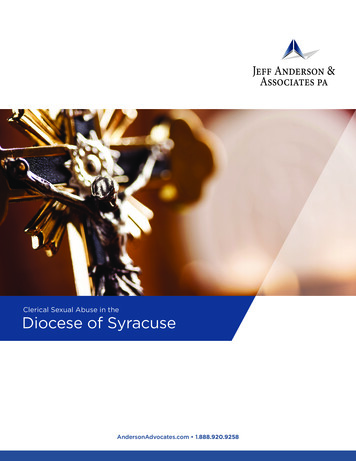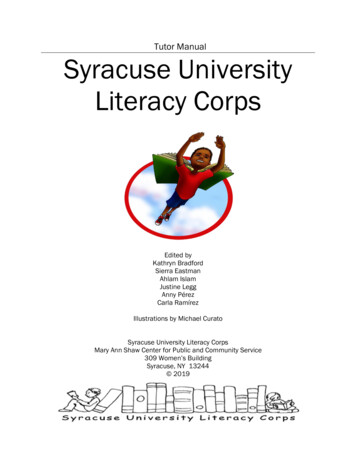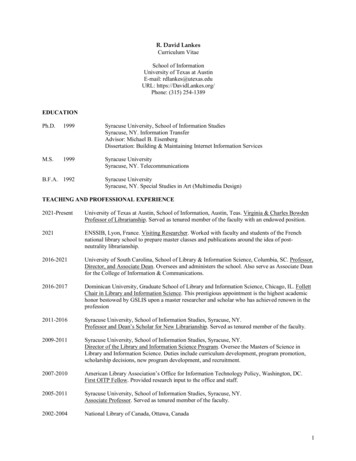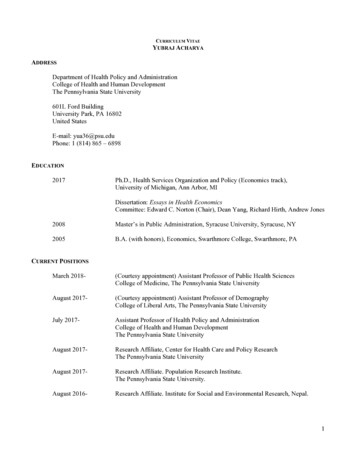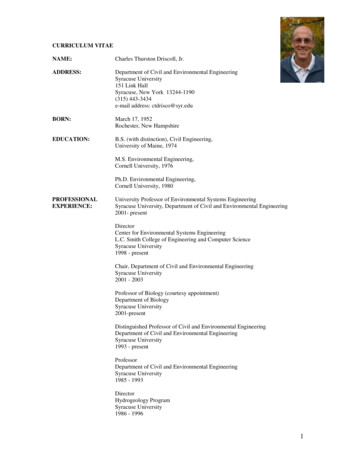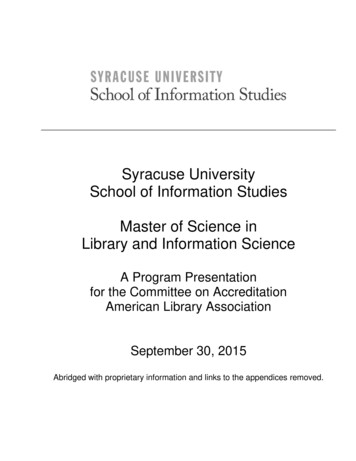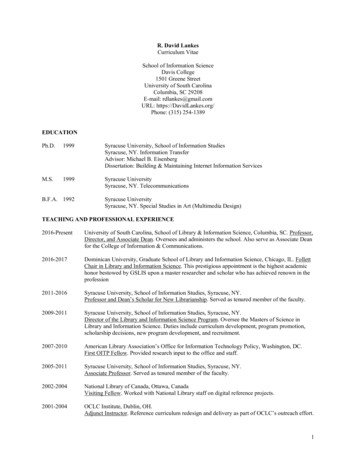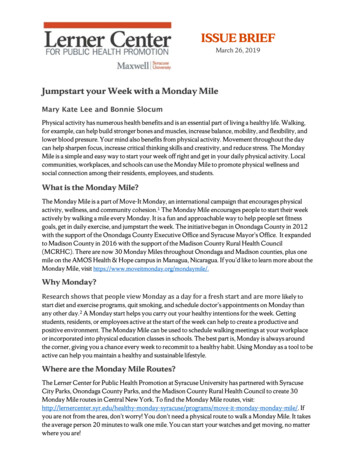
Transcription
ISSUE BRIEFMarch 26, 2019Jumpstart your Week with a Monday MileMary Kate Lee and Bonnie SlocumPhysical activity has numerous health benefits and is an essential part of living a healthy life. Walking,for example, can help build stronger bones and muscles, increase balance, mobility, and flexibility, andlower blood pressure. Your mind also benefits from physical activity. Movement throughout the daycan help sharpen focus, increase critical thinking skills and creativity, and reduce stress. The MondayMile is a simple and easy way to start your week off right and get in your daily physical activity. Localcommunities, workplaces, and schools can use the Monday Mile to promote physical wellness andsocial connection among their residents, employees, and students.What is the Monday Mile?The Monday Mile is a part of Move-It Monday, an international campaign that encourages physicalactivity, wellness, and community cohesion.1 The Monday Mile encourages people to start their weekactively by walking a mile every Monday. It is a fun and approachable way to help people set fitnessgoals, get in daily exercise, and jumpstart the week. The initiative began in Onondaga County in 2012with the support of the Onondaga County Executive Office and Syracuse Mayor’s Office. It expandedto Madison County in 2016 with the support of the Madison County Rural Health Council(MCRHC). There are now 30 Monday Miles throughout Onondaga and Madison counties, plus onemile on the AMOS Health & Hope campus in Managua, Nicaragua. If you’d like to learn more about theMonday Mile, visit https://www.moveitmonday.org/mondaymile/.Why Monday?Research shows that people view Monday as a day for a fresh start and are more likely tostart diet and exercise programs, quit smoking, and schedule doctor’s appointments on Monday thanany other day.2 A Monday start helps you carry out your healthy intentions for the week. Gettingstudents, residents, or employees active at the start of the week can help to create a productive andpositive environment. The Monday Mile can be used to schedule walking meetings at your workplaceor incorporated into physical education classes in schools. The best part is, Monday is always aroundthe corner, giving you a chance every week to recommit to a healthy habit. Using Monday as a tool to beactive can help you maintain a healthy and sustainable lifestyle.Where are the Monday Mile Routes?The Lerner Center for Public Health Promotion at Syracuse University has partnered with SyracuseCity Parks, Onondaga County Parks, and the Madison County Rural Health Council to create 30Monday Mile routes in Central New York. To find the Monday Mile routes, yracuse/programs/move-it-monday-monday-mile/. Ifyou are not from the area, don’t worry! You don’t need a physical route to walk a Monday Mile. It takesthe average person 20 minutes to walk one mile. You can start your watches and get moving, no matterwhere you are!
How Madison County, NY Made Monday ActiveIn 2016, the Madison County, NY Rural Health Council (MCRHC)3 expressed interest in theMonday Mile program because of its goal to decrease obesity by facilitating physical activity and accessto recreation space. Due to its rural nature, Madison County community members reported a lack ofparks and recreation spaces to engage in physical activity. In response, the MCRHC and the LernerCenter for Public Health Promotion at Syracuse created the Live Well Committee to address theseissues. The Live Well Committee is comprised of people who live throughout Madison County. Byworking with them to develop Monday Miles, we hoped to increase opportunities for Madison Countyresidents to be active.Stockbridge: The First Madison County Monday MileTo determine where the first Monday Mile should be located, MCRHCidentified priority neighborhoods with high childhood obesity. Stockbridgewas among the top ten school districts for childhood obesity. Lerner Centerrepresentatives and members of the Live Well Committee met with theStockbridge superintendent, principals, and teachers to pitch thedevelopment of a Monday Mile. They walked areas around the school todetermine the best location for a Monday Mile route. After receivingapproval from the Board to develop a Monday Mile on the school grounds,the Lerner Center worked with the Live Well Committee and theStockbridge school to create signage. Physical Education teachers regularlyuse the Monday Mile for their classes throughout the year.Expanding County WideTo expand routes beyond Stockbridge to other parts of Madison County, the Live Well Committeeworked with local town and village boards, town supervisors, and village mayors. To install signage, theLive Well Committee and the head of the village or town worked with their Department of PublicWorks (DPW). The DPW has been responsive to the Committee’s needs and mindful of concerns, suchas sign pollution and discerning New York State property lines from village and town lines. Communitymembers were also key stakeholders in the development and success of theMonday Miles. Volunteers have stepped up to lead the development andinstallation of routes throughout the county. For example, a communityrepresentative from the town of Stockbridge, NY helped to move theapproval process forward by contacting Stockbridge school officials. Acommittee member from the village of Morrisville, NY knew the Mayor andbegan discussing the benefits of a Monday Mile in their village. Thecommunity network is essential in making the Monday Miles a successbecause local community members are the experts about their community.The Monday Mile has improved community cohesion within MadisonCounty, as members have joined together through the Live Well Committeeunder the shared goal of making Madison County a healthier place to live.Spreading the WordAwareness of the Monday Miles has grown organically through word-of-mouth throughout thecommunity. Community members have proven to be important in promoting the Monday Miles.Members of the Live Well Committee have strong connections to their communities. Their fellowcommunity members know the committee members and trust them. Residents believe the committee isacting for the betterment of their community and the county.
3 SYRACUSE UNIVERSITY LERNER CENTER FOR PUBLIC HEALTH PROMOTIONOther marketing strategies that the Live Well Committee has used to promote the Monday Milesinclude flyers in libraries, schools, hospitals, and shared community spaces, newspaper articles, socialmedia, the Healthy Monday Syracuse and MCRHC websites, and community events.Madison County Monday Mile DayIn September 2018, the MCRHC celebrated their Monday Mile walking program with healthy snacks,prizes, and group Monday Miles. Monday Mile Day served to increase awareness about the routes andto motivate community members to get outside and get moving. Participants were encouraged to walkthe Monday Mile and complete a survey about their usage of the routes. Twelve people signed up to beMonday Mile Group Leaders. These leaders will be responsible for organizing a weekly Monday Milewalk in their community with the aim of increasing usage of the routes, physical activity, and socialconnection.How to Create a Monday Mile Route in your Community, Workplace, orSchoolStarting a Monday Mile in your community, workplace, or school is easy! Just follow these simple steps:1. Identify a 1-mile route. Routes can be indoors or outdoors. Ask yourself: Is the route familiar to your community? Is the route safe? Is the route frequently used? Does the route have cultural or historical significance (you can use this to build interest!)2. Establish a starting time & location Schedule a walking meeting. Start a walking club. Make it a weekly family, workplace, or school tradition.3. Establish Monday Mile Signage Contact the Lerner Center for signage templates and suggestions (lerner@syr.edu). Reach out to local organizations who may be interested in helping to promote physical activityor community building. Consider schools, hospitals, libraries, or your local parks department. Walk the established route and determine where signage could go. Talk with your town board or public officials to create an action plan.4. Recruit walkers. Spread the word to get the community involved. Send an office or school-wide email. Use social media #MondayMile. Invite neighbors, friends, and colleagues.Go the Extra Mile by Making Sure the Route is Accessible and InclusiveWe encourage you to consider the accessibility and inclusivity of your Monday Miles. Is the routeunobstructed, well-lit, relatively flat, and wide enough for people of all abilities? Does it have a stablesurface? For more information, visit the Inclusive recreation Resource Center.5Learn more about how to start your own Monday Mile with our Monday Mile oads/2015/05/Monday-Mile-Toolkit-2015.pdf.
Endnotes1. To learn more about Move-It Monday, visit: https://www.moveitmonday.org/about/.2. Fry, J. & Neff, R. (2010). Healthy Monday: Two Literature Reviews. Accessed Jan. 25, 2019 itutes/johns-hopkins-center-for-a-livablefuture/ pdf/projects/HM/healthymondayreport.pdf.3. To learn more about the Madison County Rural Health Council, le/.4. Lerner Center for Public Health Promotion. Move-It Monday and Monday yracuse/programs/move-it-monday-monday-mile/.5. Inclusive Recreation Resource Center. https://inclusiverec.org/inclusion-u-onlineAbout the Authors:Mary Kate Lee is the Program Coordinator for the Healthy Monday Campaign at Syracuse University(mlee77@maxwell.syr.edu). Bonnie Slocum is the Executive Director of the Madison County RuralHealth Council and Chair of the Live Well Committee (slocum.bonnie@mcruralhealthcouncil.org).The mission of the Lerner Center for Public Health Promotion at Syracuse University is toimprove population health through applied research and evaluation, education, engagedservice, and advocating for evidence-based policy and practice change.426 Eggers Hall Syracuse New York 13244
5 SYRACUSE UNIVERSITY LERNER CENTER FOR PUBLIC HEALTH PROMOTIONsyracuse.edu lernercenter.syr.edu
The Lerner Center for Public Health Promotion at Syracuse University has partnered with Syracuse City Parks, Onondaga County Parks, and the Madison County Rural Health Council to create 30 . Consider schools, hospitals, libraries, or your local parks department. Walk the established route and determine where signage could go.
